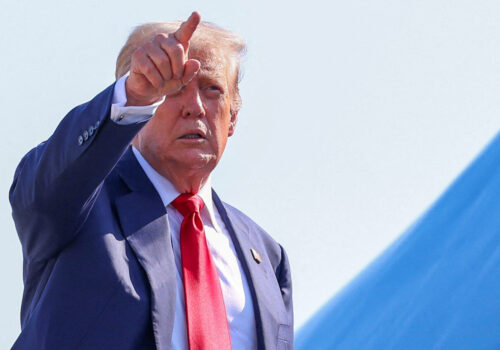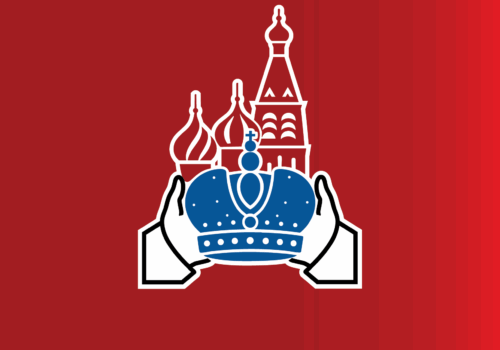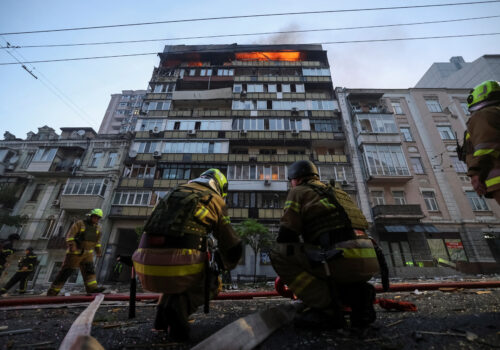The Russia pressure menu: Options to convince Putin to negotiate on Ukraine
US President Donald Trump just reminded the world that his patience is wearing thin with Russian President Vladimir Putin. This week, Trump announced that he would reduce the deadline for Russia accepting an end to military operations from fifty days to ten days. “There’s no reason for waiting,” Trump said on Monday.
During his comments Monday alongside British Prime Minister Keir Starmer in Scotland, Trump also mentioned two actions that he might take after that deadline: additional sanctions on Russia and major tariffs on countries purchasing Russian oil or gas. Those are two useful steps, but the question that the White House should be asking is what steps might eventually force Putin to accept the compromise peace that Trump has advocated since before taking office.
Since the Russian president launched his revisionist campaign with the 2008 attack on Georgia, and then his seizure of Crimea in 2014, he has managed to outlast the opposition that he has faced from the West. Trump has the ability to change this. To do so, he must abandon the dawdling, incremental policy of the Biden administration, and he must take strong military and economic measures that will prevent additional Russian gains on the battlefield and further reduce the output of an already doddering Russian economy. What might this look like?
Send offensive weapons to Ukraine
The Trump administration can make good on its willingness to send advanced weapons to Ukraine (paid for by Europe), not just Patriot missiles for air defense, but offensive weapons. If he is ready to move beyond the inherent caution of Team Biden, Trump could announce his intention to send Tomahawk missiles (with a range of over one thousand miles) if Russian bombardment of Ukrainian cities and civilians does not end in the next ten days. This could also encourage Germany to do the same with its Taurus missiles. The United States could also move quickly to reach an agreement with Ukraine for the joint production of advanced drones. This would enhance the defense capability of Ukraine and the United States. With these and other weapons in Ukraine, the United States could help Ukraine achieve the capability to threaten Russian supply lines into Crimea and core logistics points serving the front in eastern Ukraine—an important step in checking Russia’s advance and incentivizing a cease-fire.
Bolster NATO
The Trump administration could build on its success at the recent NATO Summit in The Hague to enhance the Alliance’s deterrence capabilities. It took a good step in that direction with the deployment of nuclear weapons to the United Kingdom earlier this month. It should likewise announce that any Russian missiles or drones overflying NATO airspace (on their way to Ukraine) will be treated as a hostile object and dealt with accordingly.
Ramp up sanctions and tariffs
First on July 14 and then again on July 28, Trump mentioned his intention to place secondary tariffs on Russia’s trading partners, which would likely include the two largest purchasers of Russian hydrocarbons—China and India—if Putin does not agree to a cease-fire. There has been strong momentum in Congress toward a tough sanctions-plus-secondary-tariffs bill led by Sen. Lindsey Graham (R-SC), but the reality is that—as he has shown in other areas—Trump can easily ratchet up tariffs himself. Since Moscow’s otherwise enfeebled economy is greatly boosted by Beijing and New Delhi purchasing its hydrocarbons, the threat of major tariffs could make it far more difficult for the Russian economy to support the ongoing war effort. With the recent capture of a Russian drone made largely with Chinese components on the battlefield in Ukraine, the United States could sanction China for breaking the arms embargo. Along with these tariffs and sanctions, the United States could push for greater international cooperation to shut down the “shadow fleet” carrying contraband Russian oil.
Press Europeans on the immobilized Russian state assets
Putin believes that he can outlast Western support for Ukraine and Ukrainian resources, both military and economic. An efficient way to demonstrate that this is wrong would be to arrange the transfer of the nearly $300 billion of immobilized Russian state assets to Ukraine. Over the past several weeks, Trump has shown himself to be a tough but able negotiator with his European counterparts; he could once again lean on the Europeans to do more for Ukraine. By itself, the transfer of these immobilized state assets—the vast majority of which are in European accounts—would sustain Kyiv’s military and economic needs for over three years.
***
Introducing all or most of these measures in rapid succession would deal a major blow to Putin’s confidence that time is on his side. That is the best chance to get the Russian president to negotiate a durable peace. As Trump himself said, there’s no reason for waiting.
John E. Herbst is the senior director of the Atlantic Council’s Eurasia Center and a former US ambassador to Ukraine.
Further reading
Fri, Jul 25, 2025
Putin may be miscalculating Trump’s resolve on Ukraine
New Atlanticist By John E. Herbst
Recent days have seen a steady increase in US and Western support for Ukraine and a concomitant toughening of NATO policy toward Russia.
Mon, Jul 14, 2025
The next generation: Russia’s future rulers
Russia Tomorrow By Mikhail Zygar
The latest report in the Atlantic Council’s Russia Tomorrow series explores the rising generation in the Kremlin-connected elite and what this shift means for Russia’s future.
Mon, Jul 14, 2025
Russia’s bombing campaign is killing record numbers of Ukrainian civilians
UkraineAlert By Peter Dickinson
As Russia's bombing campaign continues to escalate, June 2025 saw the highest monthly casualties among the Ukrainian civilian population in more than three years, according to new data from the UN Human Rights Monitoring Mission, writes Peter Dickinson.
Image: Russian President Vladimir Putin attends a meeting with Belgorod region governor Vyacheslav Gladkov in Moscow, Russia July 11, 2025. Sputnik/Mikhail Metzel/Pool via REUTERS



